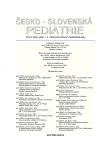Unilateral Multicystic Dysplasia of the Kidneys (A Cohort of Patients)
Authors:
Š. Doležalová; Jakub Langer
Authors place of work:
Klinika dětského a dorostového lékařství 1. LF UK a VFN, Praha
přednosta prof. MUDr. J. Zeman, DrSc
Published in the journal:
Čes-slov Pediat 2010; 65 (12): 676-681.
Category:
Původní práce
Summary
Introduction:
„Multicystic dysplastic kidney“ (MCDK) belongs to the most frequent inherited uropathies. The objective of the article is a retrospective analysis of the disease course in 80 children with MCDK, having been under observation since 1991 to 2009.
Methods:
The authors evaluated 90 children (41 boys and 39 girls). The diagnosis of MCDK was mostly established prenatally (89%). In 13 children (17%) the dysplasia was associated with pelvic or cross dystopia of the affected kidney. DMSA was performed in 73 children (91%), Miction cystourethrography (MCUG) in 66 children (82%).
Results:
A conservative treatment was applied in 69 children (86%), nephrectomy was indicated in 11 patients (14%), mostly for extreme size of the affected kidney. In 19% of children (24%), functional or structural damage of the second kidney was confirmed (hydronephrosis 5 times, obstruction megauterus twice, vesicourethral reflux 4 times, other pathology 4 times). In most cases (96%) the unaffected kidney was demonstrated to grow within the range of compensatory hypertrophy (size above 95 percentile according to Dinkel figure). In 5 patients the renal functions decreased, always in association with the defect of the functionally solitary kidney. Laboratory signs of chronic renal insufficiency last in three patients. Hypertension was proved in five children (6%), in three of them with anomalies of the other side, two patients suffered from hypertension with normal findings on the contralateral kidney, which was mitigated after nephrectomy. Malignity of multicystic kidney was not observed in any patient. In the conservatively treated children the cystic formation completely disappeared in 28 children (41%) and in other 14 subjects (20%) there was a significant reduction of the cystic formation. The cystic kidney disappeared in 32 months on the average (1 to 141 months). In 27 cases (39%) there is a stationary finding on the affected kidney.
Conclusion:
In agreement with literature our findings document the advantages and safety of the conservative approach in children with MCDK. The probability of a significant reduction of the multicystic kidney is high in children up to three year of life, but tends to decrease with age. The prognosis of the child is significantly influenced by damage of the other kidney which should be carefully investigated.
Key words:
multicystic kidney dysplasia, DMSA scan, micturition cystourethro-graphy, vesicourethral reflux, Wilms tumor
Zdroje
1. Aslam M, Watson AR. Unilateral multicystic dysplastic kidney: long term outcomes. Arch. Dis. Child. 2006; 91: 820–882.
2. Narchi H. Risk of Wilms´tumour with multicystic kidney disease: a systematic review. Arch. Dis. Child. 2005; 90: 147–149.
3. Kalyoussef E, Hwwang J, et al. Segmental multicystic dysplastic kidney in children. Urology 2006 Nov; 68(5): 1121.e9–1121.e11.
4. Floglová H, Šmakal O, Geier P, et al. Sledování dětí s unilatrální multicystickou dysplazií ledviny. Čes.-slov.Pediat. 2006; 3: 116–122.
5. Hoffman JD, Bianchi DW, Sullivan LM, et al. Down syndrome serum screening also identifies an increased risk for multicystic dysplastic kidney, two-vessel cord and hydocele. Prenat. Diagn. 2008 Dec; 28(13): 1204–1208.
6. Cambio AJ, Evans CP, et al. Non-surgical management of multicystic dysplastic kidney. BJU Int. 2008 Apr; 101(7): 804–808.
7. Schreuder MF, Westland R, et al. Unilateral multicystic dysplastic kidney: a meta-analysis of observational studies on the incidence, associated urinary tract malformation and the contralateral kidney. Nephrol. Dial. Transplant. 2009 Jun; 24(6): 1810–1818.
8. Pop-Trajkovic S, Ljubic A, Antic V, et al. Association of fetal unilateral multicystic dysplastic kidney disease with other urinary tract anomalies. Vojnosanit. Pregl. 2009 Sep; 66(9): 733–737.
9. Hains DS. Management and etiology of the unilateral multicystic dysplastic kidney: a review. Pediatr. Nephrol. 2009 Feb; 24(2): 233–241.
10. Narchi H. Risk of hypertension with multicystic kidney disease: a systematic review. Arch. Dis. Child. 2005; 90: 921–924.
11. Sukthankar S, Watson AR. Unilateral multicystic dysplastic kidney disease: definining the natural history. Acta Paediatr. 2000; 89: 811–813.
12. Kuwertz-Broeking E, Brinkmann OA, Von Lengerke HJ, et al. Unilateral multicystic dysplastic kidney: experience in children. BJU Int. 2004 Feb; 93(3): 388–392.
Štítky
Neonatológia Pediatria Praktické lekárstvo pre deti a dorastČlánok vyšiel v časopise
Česko-slovenská pediatrie

2010 Číslo 12
- Realita liečby bolesti v paliatívnej starostlivosti v Nemecku
- Využití hodnoticích skóre a objektivních nástrojů při léčbě astmatu
- Nech brouka žít… Ať žije astma!
Najčítanejšie v tomto čísle
- Autoimunitní onemocnění jater v dětském věku – část I
- Unilaterální multicystická dysplazie ledvin (soubor pacientů)
- Současné postavení dynamické scintigrafie ledvin s aplikací diuretika v dětském věku
- Infekce močových cest u dětí a dorostu, novější údaje o etiologii, diagnostice a léčbě
